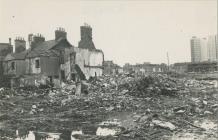Content can be downloaded for non-commercial purposes, such as for personal use or in educational resources.
For commercial purposes please contact the copyright holder directly.
Read more about the The Creative Archive Licence.
Description
Although offshore, Flat Holm Island lies within the parish of St. Mary, Cardiff and the community of Butetown, Cardiff. William Crispe and his partner, Benjamin Lund, built a lighthouse on the island which is said to have displayed its first coal-fired light in March 1738. In 1820, the lighthouse was taken over by Trinity House. The fog-station was probably established around 1860 by Trinity House.
In 1865 The War Office purchased ten acres of land on Flat Holm and the island was under military occupation between 1866 and 1903. Four batteries were built, started in 1859, armed with 80 pounder (36.29 kilogram) rifle muzzle loading guns known as the Palmerston Forts. Flat Holm Island houses a Victorian isolation hospital. The hospital (originally in tented form) was first authorised in 1883 to protect Cardiff from ship-borne cholera; it was later used by other Bristol Channel ports and for isolation of victims of other infectious diseases. The hospital was out of use by 1937. The first radio (wireless) transmission and reception in the world was made between Flat Holm and Penarth (Lavernock) by Marconi on 13 May 1897. Flat Holm was re-occupied by the military during the Second World War and developed as an important and active anti-aircraft installation. The defences were updated with searchlight batteries, 4.5 inch (114 millimetre) dual purpose guns and 40 millimetre Bofors guns, supported by Lewis gun positions. The isolation hospital was converted for wartime service in 1940-44.
Read more:
http://flatholmisland.wordpress.com/category/uncategorized/






Do you have information to add to this item? Please leave a comment
Comments (0)
You must be logged in to leave a comment